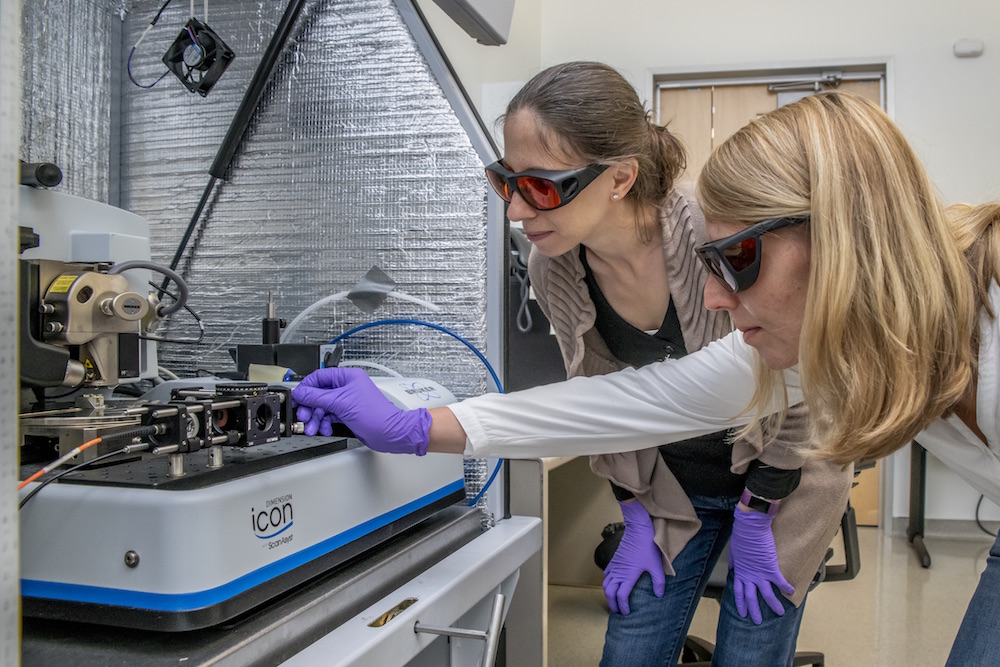As we look back at a decade of discovery, we highlight 10 recent achievements by scientists at Berkeley lab, Caltech’s lead partner. All of these advances – from designing new materials that convert carbon dioxide into sustainable chemicals and fuels without wasteful byproducts, to sophisticated devices that transform sunlight and water into electricity and fuels that could replace coal, oil, and other fossil fuels – point to Berkeley Lab’s progress toward a solar fuels future:
1. A Solar Cell That Does Double Duty for Renewable Energy
Researchers at Berkeley Lab and JCAP developed an artificial photosynthesis device that turns sunlight and water into two types of energy: hydrogen fuel and electricity. Full story here.
2. Greener Days Ahead for Carbon Fuels
Researchers at Berkeley Lab and JCAP demonstrated copper’s potential as a catalyst for turning carbon dioxide into sustainable chemicals and fuels without any wasteful byproducts, creating a green alternative to present-day chemical manufacturing. Full story here.
3. A Chemical Reaction Close-Up: New Technology Gives a Glimpse of Solar Fuel Generation in Action
JCAP scientists invented a cell that is expected to help scientists engineer and test new catalyst materials, which can be used in next-generation solar fuel devices that split water to produce hydrogen gas and convert carbon dioxide emissions into fuels like ethanol. Full story here.
4. Here Comes the Sun: A New Framework for Artificial Photosynthesis
Scientists have long sought to mimic the process by which plants make their own fuel using sunlight, carbon dioxide, and water through artificial photosynthesis devices, but how exactly substances called catalysts work to generate renewable fuel remains a mystery. In work led by Berkeley Lab and JCAP, scientists gained new insight into how to better control cobalt oxide, one of the most promising catalysts for artificial photosynthesis. Full story here.
5. Solar-to-Fuel System Recycles CO2 to Make Ethanol and Ethylene
Scientists at Berkeley Lab and JCAP successfully demonstrated the approach of going from carbon dioxide directly to target products, namely ethanol and ethylene, at energy conversion efficiencies rivaling natural counterparts. They did this by optimizing each component of a photovoltaic-electrochemical system to reduce voltage loss, and creating new materials when existing ones did not suffice. Full story here.
6. Splitting Water: Nanoscale Imaging Yields Key Insights
Researchers at Berkeley Lab and JCAP pioneered a technique that uses nanoscale imaging to understand how local, nanoscale properties in a material can affect its ability to efficiently perform photoelectrochemical water splitting, and also to understand why a certain material may or may not work in an artificial photosynthesis system. Full story here.
7. New Materials Could Turn Water into the Fuel of the Future
Scientists at Berkeley Lab and Caltech nearly doubled the number of materials known to have potential for use in solar fuels. They did so by developing a process that promises to speed the discovery of commercially viable solar fuels that could replace coal, oil, and other fossil fuels. Full story here.
8. Solar Cells Get Boost with Integration of Water-Splitting Catalyst onto Semiconductor
JCAP scientists devised a method for engineering a composite film that supports chemical reactions without damaging sensitive semiconductors in an artificial photosynthesis system designed to generate clean fuel. Full story here
9. New Discovery Could Better Predict How Semiconductors Weather Abuse
One of the major challenges for scientists working to create systems that efficiently convert sunlight, water, and carbon dioxide into fuel is finding materials that can do the work while also surviving the corrosive conditions that are part of the process. Existing methods to determine material stability have been hit and miss, but a Berkeley Lab-led team of researchers at JCAP applied a combination of experimental and theoretical tools to rigorously determine how well a material will weather the harsh environments in these systems. Full story here.
10. Some Like it Hot: Simulating Single Particle Excitations
Plasmons – clouds of electrons that oscillate within a cluster of metal nanoparticles – could serve as antennae in a photovoltaic device to absorb sunlight more efficiently than semiconductors. To leverage plasmons for a solar-cell application, scientists at Berkeley Lab used a real-time algorithm to simulate how electrons move within each nanoparticle when a plasmon is excited by light. The JCAP-supported study provided a new understanding of how long a particle is excited by light in a solar fuels device. Full story here.
###
Founded in 1931 on the belief that the biggest scientific challenges are best addressed by teams, Lawrence Berkeley National Laboratory and its scientists have been recognized with 13 Nobel Prizes. Today, Berkeley Lab researchers develop sustainable energy and environmental solutions, create useful new materials, advance the frontiers of computing, and probe the mysteries of life, matter, and the universe. Scientists from around the world rely on the Lab’s facilities for their own discovery science. Berkeley Lab is a multiprogram national laboratory, managed by the University of California for the U.S. Department of Energy’s Office of Science.
DOE’s Office of Science is the single largest supporter of basic research in the physical sciences in the United States, and is working to address some of the most pressing challenges of our time. For more information, please visit energy.gov/science.
Original post https://alertarticles.info


